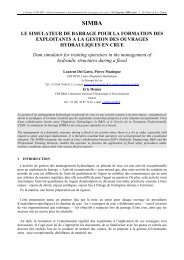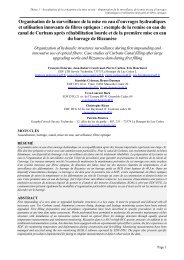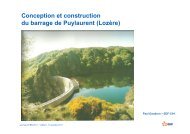SMALL DAMS
SMALL DAMS - Comité Français des Barrages et Réservoirs
SMALL DAMS - Comité Français des Barrages et Réservoirs
- No tags were found...
Create successful ePaper yourself
Turn your PDF publications into a flip-book with our unique Google optimized e-Paper software.
Chapter V<br />
Masonry dams are no longer built in France, mainly because the technique is labourintensive<br />
due to the requirement to cut and place facing rock. However, the technique<br />
is still used in some countries (China, India, Morocco, Sahelian Africa, etc.) for small<br />
dams.<br />
Conventional concrete<br />
The technique of building gravity dams with conventional vibrated concrete (CVC)<br />
was developed starting in the second decade of the 20th century. It resulted in a very<br />
great number of dams of all sizes for all kinds of use.<br />
The technology of conventional concrete gravity dams uses coarsely graded concrete<br />
aggregate (up to 80 millimetres) and cement contents in the range of 200 to 250 kg<br />
per cubic metre of concrete. Heat development relating to the hydration of the concrete<br />
as it sets leads to high increases in the concrete temperature and a risk of cracking as<br />
it cools.<br />
For that reason, conventional concrete dams are built in blocks routinely measuring 15<br />
by 15 metres horizontally, which means many contraction joints, both transversal and<br />
longitudinal, must be placed (at least in the case of high dams). For small dams, it is<br />
generally possible to build only transversal joints.<br />
The dam is given its monolithic character by placing shear boxes and by grouting the<br />
joints between the blocks.<br />
The technique of building conventional concrete gravity dams, like masonry, is labour-intensive,<br />
in particular to set formwork. This requirement for labour and the parallel<br />
development of modern earthwork techniques at high work rates have resulted in a<br />
progressive preference for earthfill or rockfill dams instead of concrete gravity dams.<br />
117<br />
Roller compacted concrete (RCC) 1<br />
The renewed interest in gravity dams is the result of the invention of RCC, which is a<br />
major technical innovation in dam technology.<br />
That innovation consists in placing and compacting the concrete, not by traditional<br />
means (transport by crane or cableway and compaction by vibration) but rather<br />
using the techniques of earthworks, e.g. dump truck transport, spreading by bulldozer<br />
and compacting with a heavy vibrating roller. However, this construction technique<br />
requires a working surface area greater than approximately 500 m 2 to allow the<br />
machinery to travel freely.<br />
The possibility of reducing to a strict minimum the quantity of mix water, and good<br />
compactness by compacting in 30 cm layers, make it possible to limit the quantities of<br />
cementitious material to values of 100 to 150 kg/m 3 in order to decrease heat<br />
development.<br />
In fact, this new construction method does not readily accommodate the many joints<br />
used to control cracking of thermal origin in conventional concrete.<br />
1. See Bibliography, reference 5, p. 139.

















